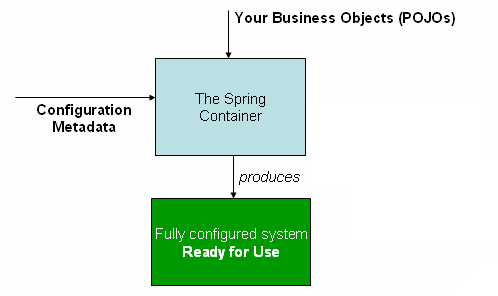容器概述
The org.springframework.context.ApplicationContext 接口代表 Spring IoC 容器,负责实例化、配置和组装 bean。容器通过读取配置元数据来获取实例化、配置和组装组件的指令。配置元数据可以表示为带注解的组件类、带有工厂方法的配置类,或者外部 XML 文件或 Groovy 脚本。无论采用哪种格式,你都可以构建你的应用以及这些组件之间丰富的相互依赖关系。
ApplicationContext 接口的几种实现在 Spring 核心中。在独立应用中,通常创建 AnnotationConfigApplicationContext 或 ClassPathXmlApplicationContext 的实例。
在大多数应用场景中,不需要显式用户代码来实例化一个或多个 Spring IoC 容器实例。例如,在普通 Web 应用场景中,应用 web.xml 文件中的简单样板 Web 描述符 XML 就足够了(参阅 Web 应用的便捷 ApplicationContext 实例化)。在 Spring Boot 场景中,应用上下文会根据常见的设置约定为你隐式启动。
下图展示了 Spring 的高级工作视图。您的应用类与配置元数据相结合,这样在创建和初始化 ApplicationContext 后,您将拥有一个完全配置好的可执行系统或应用。

配置元数据
如前图所示,Spring IoC 容器消费某种形式的配置元数据。这些配置元数据代表了您作为应用开发者如何告诉 Spring 容器实例化、配置和组装应用中的组件。
Spring IoC 容器本身与配置元数据实际编写的格式完全解耦。如今,许多开发者为他们的 Spring 应用选择 基于 Java 的配置
-
基于注解的配置:使用应用组件类上的基于注解的配置元数据定义 bean。
-
基于 Java 的配置:使用基于 Java 的配置类在应用类外部定义 bean。要使用这些特性,请参阅
@Configuration、@Bean、@Import和@DependsOn注解。
Spring 配置至少包含一个(通常不止一个)由容器管理的 bean 定义。Java 配置通常在 @Configuration 类中使用 @Bean 注解的方法,每个方法对应一个 bean 定义。
这些 bean 定义对应于构成您应用的实际对象。通常,您会定义服务层对象、持久层对象(例如仓库或数据访问对象 (DAO))、表示层对象(例如 Web 控制器)、基础设施对象(例如 JPA EntityManagerFactory、JMS 队列等)。通常,容器中不配置细粒度的领域对象,因为创建和加载领域对象通常是仓库和业务逻辑的责任。
XML 作为外部配置 DSL
基于 XML 的配置元数据将这些 bean 配置为顶级 <beans/> 元素内的 <bean/> 元素。以下示例展示了基于 XML 的配置元数据的基本结构
<?xml version="1.0" encoding="UTF-8"?>
<beans xmlns="http://www.springframework.org/schema/beans"
xmlns:xsi="http://www.w3.org/2001/XMLSchema-instance"
xsi:schemaLocation="http://www.springframework.org/schema/beans
https://www.springframework.org/schema/beans/spring-beans.xsd">
<bean id="..." class="..."> (1) (2)
<!-- collaborators and configuration for this bean go here -->
</bean>
<bean id="..." class="...">
<!-- collaborators and configuration for this bean go here -->
</bean>
<!-- more bean definitions go here -->
</beans>| 1 | id 属性是一个字符串,用于标识单个 bean 定义。 |
| 2 | class 属性定义了 bean 的类型,使用完全限定类名。 |
id 属性的值可用于引用协作对象。本示例未展示引用协作对象的 XML。有关更多信息,请参阅依赖。
为了实例化容器,需要向 ClassPathXmlApplicationContext 构造函数提供 XML 资源文件的位置路径或多个路径,该构造函数允许容器从各种外部资源(例如本地文件系统、Java CLASSPATH 等)加载配置元数据。
-
Java
-
Kotlin
ApplicationContext context = new ClassPathXmlApplicationContext("services.xml", "daos.xml");val context = ClassPathXmlApplicationContext("services.xml", "daos.xml")|
学习 Spring 的 IoC 容器后,您可能想了解更多关于 Spring 的 |
以下示例展示了服务层对象 (services.xml) 配置文件
<?xml version="1.0" encoding="UTF-8"?>
<beans xmlns="http://www.springframework.org/schema/beans"
xmlns:xsi="http://www.w3.org/2001/XMLSchema-instance"
xsi:schemaLocation="http://www.springframework.org/schema/beans
https://www.springframework.org/schema/beans/spring-beans.xsd">
<!-- services -->
<bean id="petStore" class="org.springframework.samples.jpetstore.services.PetStoreServiceImpl">
<property name="accountDao" ref="accountDao"/>
<property name="itemDao" ref="itemDao"/>
<!-- additional collaborators and configuration for this bean go here -->
</bean>
<!-- more bean definitions for services go here -->
</beans>以下示例展示了数据访问对象 daos.xml 文件
<?xml version="1.0" encoding="UTF-8"?>
<beans xmlns="http://www.springframework.org/schema/beans"
xmlns:xsi="http://www.w3.org/2001/XMLSchema-instance"
xsi:schemaLocation="http://www.springframework.org/schema/beans
https://www.springframework.org/schema/beans/spring-beans.xsd">
<bean id="accountDao"
class="org.springframework.samples.jpetstore.dao.jpa.JpaAccountDao">
<!-- additional collaborators and configuration for this bean go here -->
</bean>
<bean id="itemDao" class="org.springframework.samples.jpetstore.dao.jpa.JpaItemDao">
<!-- additional collaborators and configuration for this bean go here -->
</bean>
<!-- more bean definitions for data access objects go here -->
</beans>在前面的示例中,服务层由 PetStoreServiceImpl 类和两个数据访问对象组成,类型分别为 JpaAccountDao 和 JpaItemDao(基于 JPA 对象关系映射标准)。property name 元素引用 JavaBean 属性的名称,ref 元素引用另一个 bean 定义的名称。id 和 ref 元素之间的这种关联表达了协作对象之间的依赖关系。有关配置对象依赖项的详细信息,请参阅依赖。
组合基于 XML 的配置元数据
将 bean 定义分布在多个 XML 文件中会很有用。通常,每个单独的 XML 配置文件代表架构中的一个逻辑层或模块。
您可以使用 ClassPathXmlApplicationContext 构造函数从 XML 片段加载 bean 定义。这个构造函数接受多个 Resource 位置,如上一节所示。或者,使用一个或多个 <import/> 元素的出现来从另一个文件或多个文件加载 bean 定义。以下示例展示了如何做到这一点
<beans>
<import resource="services.xml"/>
<import resource="resources/messageSource.xml"/>
<import resource="/resources/themeSource.xml"/>
<bean id="bean1" class="..."/>
<bean id="bean2" class="..."/>
</beans>在前面的示例中,外部 bean 定义从三个文件加载:services.xml、messageSource.xml 和 themeSource.xml。所有位置路径都相对于进行导入的定义文件,因此 services.xml 必须与进行导入的文件位于同一目录或类路径位置,而 messageSource.xml 和 themeSource.xml 必须位于导入文件位置下的 resources 位置。正如您所见,开头的斜杠会被忽略。但是,考虑到这些路径是相对的,最好根本不使用斜杠。被导入文件的内容(包括顶级 <beans/> 元素)必须根据 Spring Schema 是有效的 XML bean 定义。
|
可以使用相对路径 "../" 引用父目录中的文件,但不推荐这样做。这样做会创建对当前应用外部文件的依赖。特别是,对于 您始终可以使用完全限定的资源位置而不是相对路径:例如, |
命名空间本身提供了导入指令功能。Spring 提供的一系列 XML 命名空间中提供了超出普通 bean 定义的更多配置特性 — 例如,context 和 util 命名空间。
Groovy Bean 定义 DSL
作为外部化配置元数据的另一个示例,bean 定义也可以使用 Spring 的 Groovy Bean Definition DSL 来表达,这在 Grails 框架中很常见。通常,这种配置位于一个 ".groovy" 文件中,其结构如下例所示
beans {
dataSource(BasicDataSource) {
driverClassName = "org.hsqldb.jdbcDriver"
url = "jdbc:hsqldb:mem:grailsDB"
username = "sa"
password = ""
settings = [mynew:"setting"]
}
sessionFactory(SessionFactory) {
dataSource = dataSource
}
myService(MyService) {
nestedBean = { AnotherBean bean ->
dataSource = dataSource
}
}
}这种配置风格与 XML bean 定义基本等效,甚至支持 Spring 的 XML 配置命名空间。它还允许通过 importBeans 指令导入 XML bean 定义文件。
使用容器
The ApplicationContext 是一个高级工厂接口,能够维护不同 bean 及其依赖项的注册表。通过使用方法 T getBean(String name, Class<T> requiredType),您可以检索 bean 的实例。
The ApplicationContext 允许您读取 bean 定义并访问它们,如下例所示
-
Java
-
Kotlin
// create and configure beans
ApplicationContext context = new ClassPathXmlApplicationContext("services.xml", "daos.xml");
// retrieve configured instance
PetStoreService service = context.getBean("petStore", PetStoreService.class);
// use configured instance
List<String> userList = service.getUsernameList();import org.springframework.beans.factory.getBean
// create and configure beans
val context = ClassPathXmlApplicationContext("services.xml", "daos.xml")
// retrieve configured instance
val service = context.getBean<PetStoreService>("petStore")
// use configured instance
var userList = service.getUsernameList()使用 Groovy 配置,启动过程看起来非常相似。它有一个不同的上下文实现类,该类感知 Groovy(但也理解 XML bean 定义)。以下示例展示了 Groovy 配置
-
Java
-
Kotlin
ApplicationContext context = new GenericGroovyApplicationContext("services.groovy", "daos.groovy");val context = GenericGroovyApplicationContext("services.groovy", "daos.groovy")最灵活的变体是 GenericApplicationContext 结合读者委托(reader delegates)— 例如,使用 XmlBeanDefinitionReader 处理 XML 文件,如下例所示
-
Java
-
Kotlin
GenericApplicationContext context = new GenericApplicationContext();
new XmlBeanDefinitionReader(context).loadBeanDefinitions("services.xml", "daos.xml");
context.refresh();val context = GenericApplicationContext()
XmlBeanDefinitionReader(context).loadBeanDefinitions("services.xml", "daos.xml")
context.refresh()您也可以对 Groovy 文件使用 GroovyBeanDefinitionReader,如下例所示
-
Java
-
Kotlin
GenericApplicationContext context = new GenericApplicationContext();
new GroovyBeanDefinitionReader(context).loadBeanDefinitions("services.groovy", "daos.groovy");
context.refresh();val context = GenericApplicationContext()
GroovyBeanDefinitionReader(context).loadBeanDefinitions("services.groovy", "daos.groovy")
context.refresh()您可以在同一个 ApplicationContext 上混合和匹配这些读者委托,从不同的配置源读取 bean 定义。
然后,您可以使用 getBean 来检索 bean 的实例。ApplicationContext 接口还有一些用于检索 bean 的其他方法,但理想情况下,您的应用代码永远不应使用它们。实际上,您的应用代码根本不应该调用 getBean() 方法,因此完全不依赖于 Spring API。例如,Spring 与 Web 框架的集成提供了对各种 Web 框架组件(如控制器和 JSF 管理的 bean)的依赖注入,允许您通过元数据(例如自动装配注解)声明对特定 bean 的依赖。

